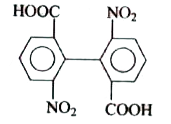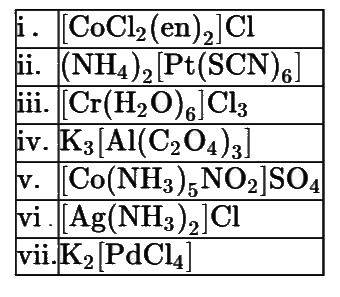Which among the following can exhibit cis-trans isomerism
CoCl3.4NH3
CoCl3.6NH3
CoCl3.5NH3
All of these
The correct Answer is:A
To determine which compounds can exhibit cis-trans isomerism, we need to analyze each compound provided in the question. Cis-trans isomerism is a type of geometrical isomerism where the arrangement of ligands around a central atom can lead to different spatial configurations.
1. Understanding Cis-Trans Isomerism:
- Cis-trans isomerism occurs in coordination compounds where there are two or more different ligands attached to a central metal atom. The ligands can be arranged in different spatial orientations.
2. Analyzing Compound A: (CoCl(NH3)4(H2O)):
- In this compound, we have one water (H2O) ligand and one chloride (Cl) ligand, with four ammonia (NH3) ligands.
- Cis Isomer: The Cl and H2O ligands are adjacent to each other.
- Trans Isomer: The Cl and H2O ligands are opposite each other.
- Conclusion: Compound A can exhibit cis-trans isomerism.
3. Analyzing Compound B: (CoCl3(NH3)3):
- This compound has three chloride ligands and three ammonia ligands.
- Facial Isomer (FAC): All three Cl ligands are on one face of the octahedron.
- Meridional Isomer (MER): The Cl ligands are arranged such that one pair is opposite each other.
- Conclusion: Compound B can exhibit cis-trans isomerism.
4. Analyzing Compound C: (CoCl2(NH3)4):
- This compound has two chloride ligands and four ammonia ligands.
- Cis Isomer: Both Cl ligands are adjacent to each other.
- Trans Isomer: The Cl ligands are opposite each other.
- Conclusion: Compound C can exhibit cis-trans isomerism.
5. Final Conclusion:
- Since all three compounds (A, B, and C) can exhibit cis-trans isomerism, the correct answer is that all of them can show this type of isomerism.
Final Answer:
All of the given compounds can exhibit cis-trans isomerism.
- Cis-trans isomerism occurs in coordination compounds where there are two or more different ligands attached to a central metal atom. The ligands can be arranged in different spatial orientations.
- In this compound, we have one water (H2O) ligand and one chloride (Cl) ligand, with four ammonia (NH3) ligands.
- Cis Isomer: The Cl and H2O ligands are adjacent to each other.
- Trans Isomer: The Cl and H2O ligands are opposite each other.
- Conclusion: Compound A can exhibit cis-trans isomerism.
- This compound has three chloride ligands and three ammonia ligands.
- Facial Isomer (FAC): All three Cl ligands are on one face of the octahedron.
- Meridional Isomer (MER): The Cl ligands are arranged such that one pair is opposite each other.
- Conclusion: Compound B can exhibit cis-trans isomerism.
- This compound has two chloride ligands and four ammonia ligands.
- Cis Isomer: Both Cl ligands are adjacent to each other.
- Trans Isomer: The Cl ligands are opposite each other.
- Conclusion: Compound C can exhibit cis-trans isomerism.
- Since all three compounds (A, B, and C) can exhibit cis-trans isomerism, the correct answer is that all of them can show this type of isomerism.
All of the given compounds can exhibit cis-trans isomerism.
Topper's Solved these Questions
- CHEMISTRY AT A GLANCEBOOK - ALLENCHAPTER - CHEMISTRY AT A GLANCEEXERCISE - ORGANIC CHEMISTRY
472 Videos
- CHEMISTRY AT A GLANCEBOOK - ALLENCHAPTER - CHEMISTRY AT A GLANCEEXERCISE - ORGANIC CHEMISTRY
472 Videos
- Chemical EquilibriumBOOK - ALLENCHAPTER - Chemical EquilibriumEXERCISE - All Questions
30 Videos
- ELECTROCHEMISTRYBOOK - ALLENCHAPTER - ELECTROCHEMISTRYEXERCISE - EXERCISE -05 [B]
38 Videos
Similar Questions
Knowledge Check
Which of the following would exhibit cis-trans isomerism?
ACH3CH2CH=CH2BClCH=CHClCClCH=CCl2DCH2=CH−COOHWhich of the following compounds exhibit optical isomerism?
A BH2C=C=CH2C
BH2C=C=CH2C D
D
Which of the following compounds will exhibit cis-trans (geometrical) isomerism?
ABut-2-eneBBut-2-yneCButan-2-olDBut-1-ene
Which of the following can exhibit tautomerism:
View SolutionWhich of the following will exhibit geometrical isomerism?
View SolutionWhich of the following compounds will exhibit cis-trans (geometrical ) isomerism ?
View SolutionWhich of the following compounds will exhibit cis-trans (geometrical ) isomerism ?
View SolutionWhich of the following compounds exhibits linkage isomerism?
View Solution

